The Impact of Different Leaf Pulling Treatments in Cabernet Franc (in Collaboration with Cain Hickey) (2017)
Emily Pelton
Veritas Vineyards and Winery
Summary
This study examines the impact of different leaf pulling regimes on ripening in Cabernet Franc. Grapes received either: 1) No leaf pulling, 2) Standard leaf pulling (leaf pulling before mid-June on East side of vine), 3) pre-bloom leaf pulling (May 17, both sides of vine), 4) post fruit-set leaf pulling (June 2, both sides of vine), 5) Mechanical leaf pulling (May 26, post fruit-set, both sides of vine), 6) bagged clusters (July 22). Grapes were harvested on the same day. All other treatments were identical. Mechanical Leaf Pulling and Post-Fruit Set Leaf Pulling had the smallest average berry weight (no data is available for the bagged clusters). Pre-bloom leaf removal saw the greatest increase in average berry weight, but this was not significant when compared with No Leaf Pulling and Post-Fruit Set. Yield per vine was significantly lower on the pre-bloom leaf removal compared to No Leaf Pulling and Post-Fruit Set, but Brix was significantly higher. This yield difference likely resulted from the significantly lower cluster weight in the Pre-Bloom treatment, as well as the lower number of berries per cluster and the lower number of clusters per vine found in the leaf pulling treatments. The Pre-Bloom and Post-Fruit Set treatments spent much more time at critical temperatures between 35-40°C than the No Leaf Pulling treatment, due to greater exposure of the grapes. The Pre-Bloom treatment was overall cooler than the Post-Fruit Set treatment, possibly because of the decreased berries per cluster and thus looser cluster architecture allowing for better air flow and cooling.
Leaf pulling always increased tannin, quercetin, and anthocyanin concentration in grapes, with the greatest concentration of tannin in the Pre-bloom Leaf Removal and anthocyanin and quercetin in the Post-Fruit Set Leaf Removal. Leaf-pulled juice tended to have less malic acid and lower YAN. In general, TA and color was higher in finished wine with leaf pulling, with the greatest increases seen in post-fruit set leaf pulling. Caftaric acid, gallic acid, quercetin, tannin, and anthocyanin were generally increased by leaf pulling, with the most profound differences found in pre-bloom and post-fruit set leaf pulling. Bagged clusters showed much lower color and tartaric acid.
Due to the complexity of this project, the Mechanical Leaf Pulling and Bagged treatments were not tasted. Overall, descriptive results for these wines were inconsistent between tastings. Wines which had received leaf pulling were generally more preferred by judges, with preferences generally being for early leaf pulling regimes. This study should be repeated several times in order to further validate these results. It should also be performed on different grape varieties, at different sites, and on different trellising systems. More rigorous descriptive work should be performed on these projects, as well.
Introduction
Leaf pulling in the fruiting zone reduces disease pressure, helps fruit to dry, and can improve chemical composition of the fruit. However, removing too many leaves can result in too high of acid reduction and sunburn. Generally, leaf pulling is performed at or after fruit set, which increases the fruit’s resistance to sunburn (Wolf 2001). However, leaf removal is often performed after berry set. Recently, great interest has arisen in investigating the impact of the timing of leaf removal on fruit yield, micro-climate, and quality.
Because basal leaves at bloom are the primary source of carbohydrates for inflorescences at this stage (Coombe 1962), pre-bloom leaf removal reduces set, potentially reduces berry size, and thus reduces cluster weight (Poni et al. 2006; Tardaguila et al. 2010, Gatti et al. 2012, Palliotti et al. 2012, Risco et al. 2014; Bubola et al. 2017). Early leaf removal results in less compact clusters, which helps to reduce Botrytis incidence as well as reduces crop yield, which may be of benefit from high yield vineyards or with compact clusters (Palliotti et al. 2011; Bubola et al. 2017). It also tends to reduce berry size and enhance many chemical ripeness parameters, such as increasing Brix, tannin, and athocyanin (Diago et al. 2012, Palliotti et al. 2012, Lee and Skinkis 2013, Cook et al. 2015, Silvestroni et al. 2016; Smith and Centinari 2017; Bubola et al. 2017). Pyrazine is often lowered due to leaf pulling, with early leaf removal often having more impact than later leaf removal (Scheiner et al. 2010). Indeed, early leaf pulling can sometimes impact these ripeness parameters in grapes to a greater extent than cluster thinning, particular in high vigor varieties where cluster thinning does not alter canopy microclimate much (Bubola et al. 2017).
The purpose of this study was to compare many different kinds of treatments on Cabernet Franc, involving the timing and degree of leaf pulling, as well as the impact of bagging grape clusters during the growing season.
Results and Discussion
Mechanical Leaf Pulling and Post-Fruit Set Leaf Pulling had the smallest average berry weight (no data is available for the bagged clusters). Pre-bloom leaf removal saw the greatest increase in average berry weight, but this was not significant when compared with No Leaf Pulling and Post-Fruit Set. However, in-house data showed relatively consistent berry weights by harvest time, except for lower cluster weights in the Mechanical Leaf Pulling and in the Post-Fruit Set Leaf Pulling treatments. Yield per vine was significantly lower on the pre-bloom leaf removal compared to No Leaf Pulling and Post-Fruit Set, but Brix was significantly higher. This yield difference likely resulted from the significantly lower cluster weight in the Pre-Bloom treatment, as well as the lower number of berries per cluster and the lower number of clusters per vine found in the leaf pulling treatments. However, there were also less clusters per vine on the Pre-Bloom and Post-Fruit Set leaf pulling treatments which may have impacted these yield results as well. It is unclear why this occurred, although it could possibly have been due to more shoot damage occurring during the leaf pulling. In the future, shoots per vine should also be counted.
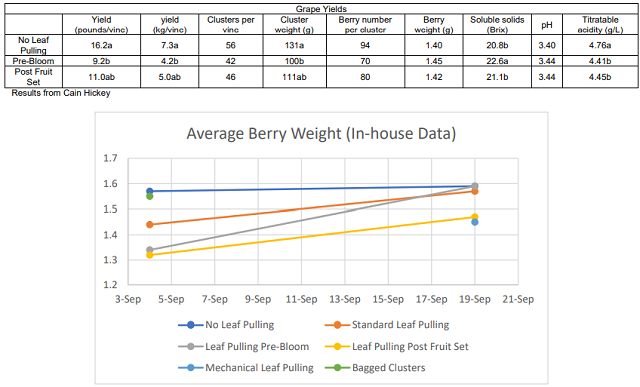
The Pre-Bloom and Post-Fruit Set treatments spent much more time at critical temperatures between 35-40°C than the No Leaf Pulling treatment, due to greater exposure of the grapes. The Pre-Bloom treatment was overall cooler than the Post-Fruit Set treatment, possibly because of the decreased berries per cluster and thus looser cluster architecture allowing for better air flow and cooling.

Leaf pulling always increased tannin, quercetin, and anthocyanin concentration in grapes, with the greatest concentration of tannin in the Pre-bloom Leaf Removal and anthocyanin and quercetin in the Post-Fruit Set Leaf Removal. Leaf-pulled juice tended to have less malic acid and lower YAN. Thus, leaf pulling tended to increase “ripeness” parameters in the grapes, with greater differences generally being found in earlier leaf pulling.
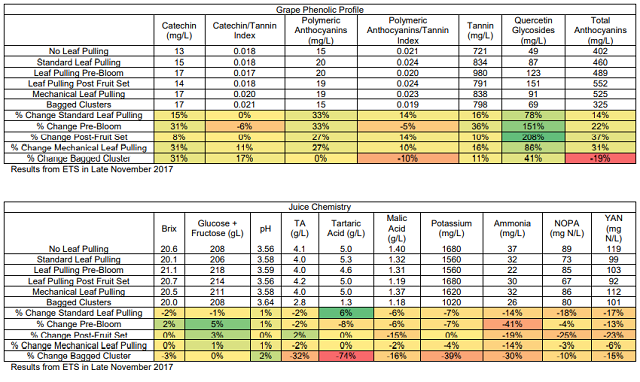
In general, TA and color was higher in finished wine with leaf pulling, with the greatest increases seen in post-fruit set leaf pulling. Caftaric acid, gallic acid, quercetin, tannin, and anthocyanin were generally increased by leaf pulling, with the most profound differences found in pre-bloom and post-fruit set leaf pulling. Bagged clusters showed much lower color and tartaric acid.

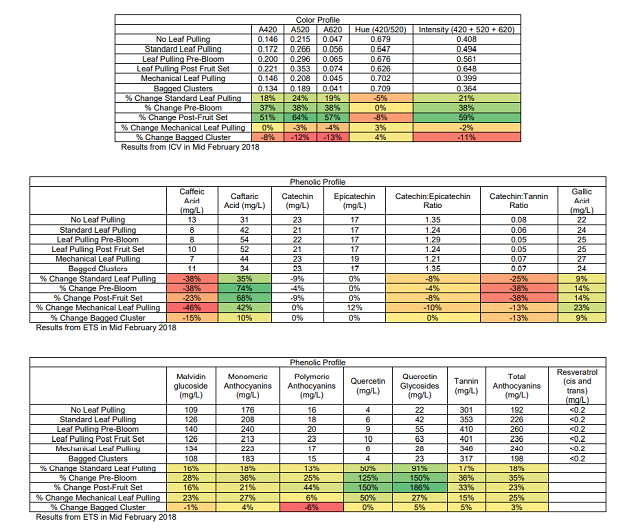
For the descriptive analysis on May 2, there were no strong trends for the descriptors used in this study. The Pre-Bloom treatment had a slight tendency towards lower Fruit Intensity and Overall Aromatic Intensity and higher Astringency. No Leaf Removal and Pre-Bloom Leaf Removal had a slight tendency for higher Herbaceous/Green character. Post-Fruit Set Leaf Removal had a slight tendency for higher Overall Aromatic Intensity and Body, and lower Astringency. Standard Leaf Pulling tended to have higher Acidity and Fruit Intensity, and lower Body. These differences, however, were weak. Leaf pulling tended to be preferred over no leaf pulling, although trends among leaf pulling regimens are difficult to distinguish. The pre-bloom leaf pulling was rarely the least preferred and tended to be slightly more preferred than the other leaf pulling treatments.
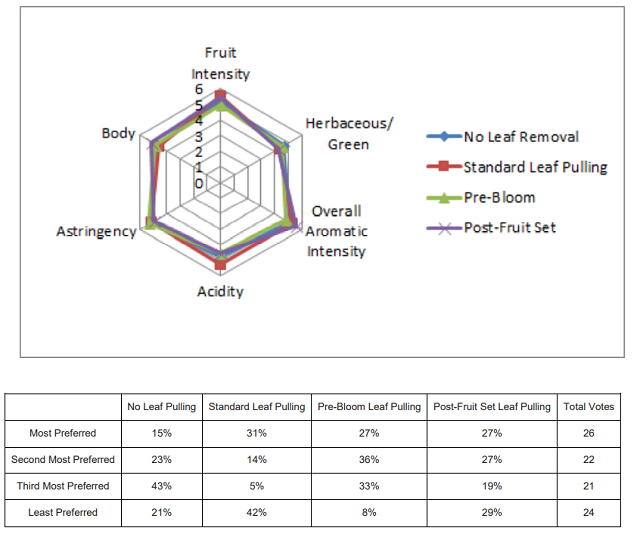
For the descriptive analysis on May 9, there were no strong trends for the descriptors used in this study. There was a slight tendency for Pre-bloom and Post-fruit set leaf pulling to increase Fruit Intensity, Acidity, and Body. These treatments were similar to No leaf removal in Herbaceous/Green quality. Post-fruit set leaf removal had a slight tendency to increase Overall Aromatic Intensity as well. Standard Leaf Removal tended to be lower in most attributes. Preferences were difficult to determine, but Post-fruit set leaf removal tended to be more preferred.
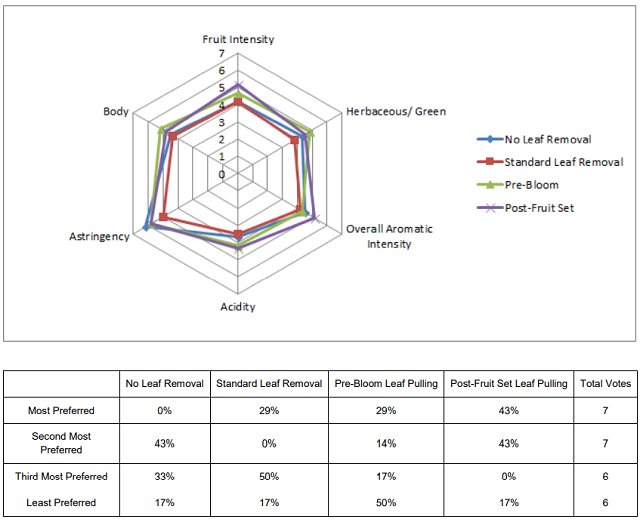
Overall, descriptive results for these wines were inconsistent between tastings. Wines which had received leaf pulling were generally more preferred by judges, with preferences generally being for early leaf pulling regimes. This study should be repeated several times in order to further validate these results. It should also be performed on different grape varieties, at different sites, and on different trellising systems. More rigorous descriptive work should be performed on these projects, as well.
Methods
This project was performed at Veritas Vineyards and Winery, Tonkins Field Cabernet Franc, which is made up of 17 year old diseased vines (leaf roll, which can hinder ripening) on 7’ x 9’ spacing in North South facing rows. All vines were spur pruned down to 3 to 5 shoots per foot. On average there were 28 shoots per vine. All vines were on VSP and they were all hedged on 3 occasions to control vigor. Two acres of vines were dedicated to this research: 0.4 acres (4 rows) for each treatment, which is approximately 276 vines or 1,932 linear feet of cordon. Some vines were young or missing. The treatments were as follows:
- Pre Bloom leaf removal (May 17). First six leaves removed, which is 2 leaves above the top flower bud.
- Post Fruit Set Leaf removal (June 2, peppercorn-size berries). First six leaves removed, which is 2 leaves above the top flower bud.
- No leaf removal. Hedging as necessary.
- In addition to the above treatments that UGA/Virginia Tech are conducting research on we also made wine from the following:
- Traditional Standard Operating Procedure of removing leaves on eastern side of the canopy only prior to mid June leaving a divided canopy on the West side only.
- Pneumatic air leaf removal (Mechanical) (May 26) on both East and West facing sides post fruit set and prior to berries getting to pea size.
- Bags. All clusters were wrapped in white paper bags just prior to veraison (July 22).
The weather was very good. There were many early rains, with 13.1 inches alone in May. The vines were sprayed every 7 to 10 days but despite this they got phomopsis on the canes but little if any other disease on the fruit. In June there was a healthy 3.1 inches of rain and July had just 0.9 inches. There was a further 3.25 inches of rain in August principally from just 2 rain events but otherwise it was sunny and good for ripening. Then in early September (September2-9) Hurricanes Harvey and Irma gave just under 3 inches of rain. Then it was dry until Hurricane Nate dropped 1 inch on October 9. Temperatures were average.
All six treatments were picked on September 27, 2017 into ventillated 600 lb harvest bins and refrigerated overnight. This was in order to show absolute differences with no chance of weather differences between the treatments. The next day the treatments were destemmed with crush into t-bins with an additon of 40ppm sulfur dioxide and put back in for cold soak, maintaining a juice temp less than 45°F overnight. At this point, grape and juice samples were frozen for later laboratory analysis. The next day Color Pro was added at 16ml/HL and Gaia was added at 15g/hL following a pumpover. The Tbins remained in cold soak for three days with a pumpover each day and then were heated and inoculated with 20g/hL Xpure rehydrated with 6g/hL Fermoplus Energy Glu. Nutrient addition was made using Actimax Natura at 35 g/hL with the addition split up in three equal adds. For the first two days of alcoholic fermentation the bins were pumped over twice per day. After that the bins were punched down three times a day during active alcoholic fermentation, tapering off towards the end. All treatments had very similar fermentation kinetics, and all of the fermentations went to dryness. Once fermentation was complete all treatments were punched and gassed one time per day. The treatments were all pressed off on the same day 29 days after harvest with 14 days of extended maceration. After settling the treatments were barreled in identical French oak barrels. At this point a wine panel was conducted and malolactic fermentation was already complete, so sulfur dioxide was added at 35ppm, and 0.3g/L of tartaric acid was added to each barrel for microbial stability.
These wines were tasted on May 2 and May 9. In order to balance the data set to perform statistical analysis for descriptive analysis on the May 2 tasting, any judge who had not fully completed the descriptive analysis ratings were removed. There was a final data set of 3 groups, each with 7 judges (considered as replications within groups, and groups were considered as assessors). Data was analyzed using Panel Check V1.4.2. Because this is not a truly statistical set-up, any results which are found to be statistically significant (p<0.05) will be denoted as a “strong trend” or a “strong tendency,” as opposed to general trends or tendencies. The statistical significance here will ignore any other significant effects or interactions which may confound the results (such as a statistically significant interaction of Judge x Wine confounding a significant result from Wine alone). The descriptors used in this study were Fruit Intensity, Herbaceous/Green, Overall Aromatic Intensity, Acidity, Astringency, and Body.
The same procedures for data analysis were used on the May 9 tasting. For the descriptive analysis in this tasting, each group had two judges, for a total of 6 judges.
References
Bubola, M., Paolo Sivilotti, P., Janjanin, D., and Poni, S. 2017. Early leaf removal has larger effect than cluster thinning on cv. Teran grape phenolic composition. Am. J. Enol. Vitic. In Press.
Cook, M.G., Zhang, Y., Nelson, C.J., Gambetta, G., Kennedy, J.A., and Kurtural, S.K. 2015. Anthocyanin composition of Merlot is ameliorated by light microclimate and irrigation in Central California. Am J Enol Vitic 66: 266-278.
Coombe, B.G. 1962. The effect of removing leaves, flowers and shoot tips on fruit-set in Vitis vinifera L. J. Hortic. Sci. 37:1-15.
Coombe, B.G. 1962. The effect of removing leaves, flowers and shoot tips on fruit-set in Vitis vinifera L. J Hortic Sci 37:1-15. 423
Diago, M.P., Ayestarán, B., Guadalupe, Z., Poni, S., and Tardáguila, J. 2012. Impact of prebloom and fruit set basal leaf removal on the flavonol and anthocyanin composition of Tempranillo grapes. Am J Enol Vitic 63:367-376.
Gatti, M., Bernizzoni, F., Civardi, S., and Poni, S. 2012. Effects of cluster thinning and preflowering leaf removal on growth and grape composition in cv. Sangiovese. Am J Enol Vitic 63:325-332.
Lee, J. and Skinkis, P.A. 2013. Oregon 'Pinot noir' grape anthocyanin enhancement by early leaf removal. Food Chem 139:893-901.
Palliotti, A., Gardi, T., Berrios, J.G., Civardi, S., and Poni, S. 2012. Early source limitation as a tool for yield control and wine quality improvement in a high-yielding red Vitis vinifera L. cultivar. Sci Hortic 145:10-16.
Palliotti, A., Gatti, M., and Poni, S. 2011. Early leaf removal to improve vineyard efficiency: gas exchange, source-to-sink balance, and reserve storage responses. Am J Enol Vitic 62:219-228.
Poni, S., Casalini, L., Bernizzoni, F., Civardi, S., and Intrieri, C. 2006. Effects of early defoliation on shoot photosynthesis, yield components, and grape composition. Am J. Enol. Vitic. 57: 397-407.
Risco, D., Pèrez, D., Yeves, A., Castel, J.R., and Intrigliolo, D.S. 2014. Early defoliation in a temperate warm and semi-arid Tempranillo vineyard: vine performance and grape composition. Aust J Grape Wine Res 20:111-122.
Scheiner, J.J., Sacks, G.L., Pan, B., Ennahli, S., Tarlton, L., Wise, A., Lerch, S.D., and Vanden Heuvel, J.E. 2010. Impact of severity and timing of basal leaf removal on 3-isobutyl-2-methoxypyrazine concentrations in red winegrapes. Am. J. Enol. Vitic. 61: 358-364.
Silvestroni, O., Lanari, V., Lattanzi, T., Alberto, A., and Sabbatini, P. 2016. Impact of crop control strategies on performance of high-yielding Sangiovese grapevines. Am J Enol Vitic 67:407-418.
Smith, M. and Centinari, M. 2017. Early season grapevine canopy management, Part II: Early leaf removal (ELR). Wine & Grapes U. https://psuwineandgrapes.wordpress.com/2017/06/02/earlyseason-grapevine-canopy-management-part-ii-early-leaf-removal-elr/
Sternad Lemut, M., Sivilotti, P., Butinar, L., Laganis, J., and Vrhovsek, U. 2015. Pre-flowering leaf removal alters grape microbial population and offers good potential for a more sustainable and cost-effective management of a Pinot Noir vineyard. Aust J Grape Wine Res 21:439-450.
Tardáguila, J., de Toda, F.M., Poni, S. and Diago, M.P. 2010. Impact of early leaf removal on yield and fruit and wine composition of Vitis vinifera L. Graciano and Carignan. Am J Enol Vitic 61:372-381.
Wolf, T. 2001. Canopy management tips. Viticulture Notes 16(3). Vineyard and Winery Information Series. http://www.sites.ext.vt.edu/newsletter-archive/viticulture/01mayjune/01mayjune.html
